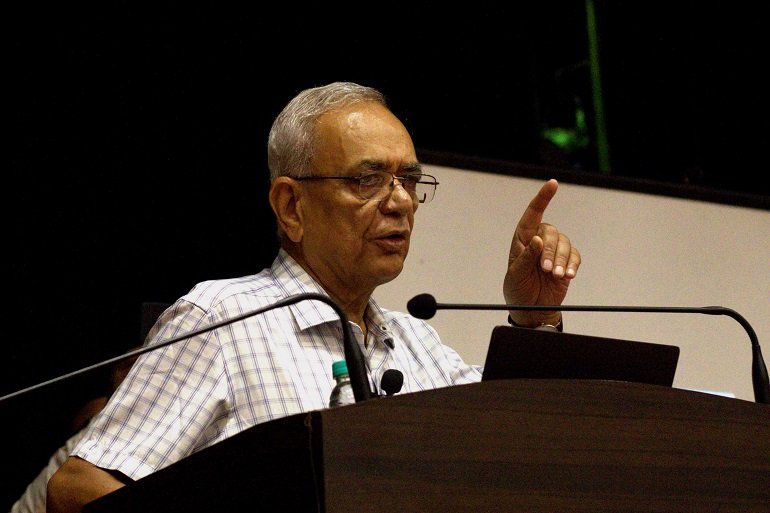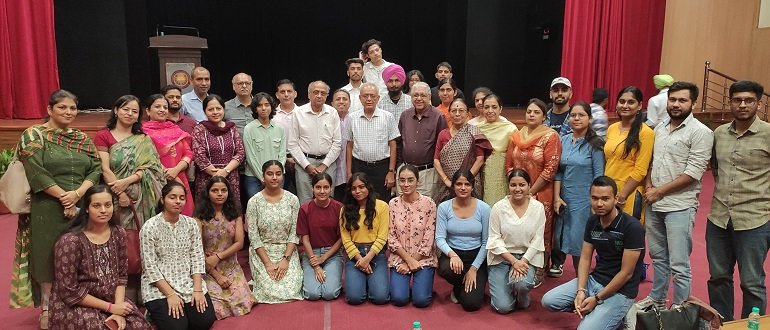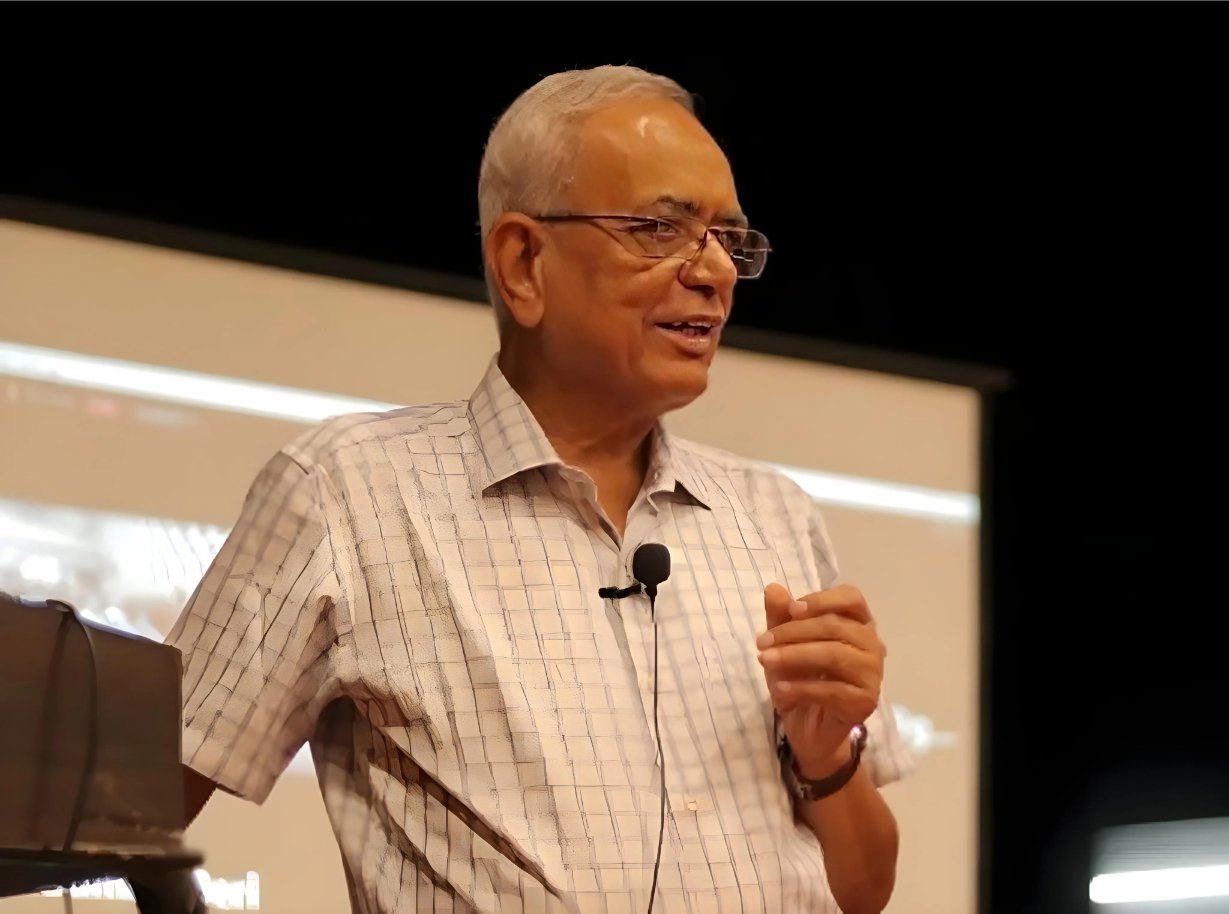Noted astronomer and astrophysicist Prof Ajit Kembhavi on Friday took curious students of DAV College-10 Chandigarh on a journey of technological development of the telescope ‘From Galileo to the James Webb Space Telescope’ in a quest to more deeply and comprehensively understand the fascinating world of planets, stars, galaxies, constellations, the milky way, black holes, white dwarfs, neutron stars, supernovas, and more.
In a presentation on this topic, Prof Kembhavi, a former Director at the Inter-University Centre for Astronomy & Astrophysics (IUCAA), Pune, and ex-member of the Space Commission, shared that it was not Italian astronomer and physicist Galileo Galilei who invented the telescope, but he was the first to use a small optical telescope to study the universe. Beginning in 1609, he went on to make some startling astronomical discoveries.

Noted astronomer & astrophysicist Prof Ajit Kembhavi delivering a talk on the topic ‘From Galileo to the James Webb Space Telescope’ at DAV College, Sector 10, Chandigarh, on Friday.
Photo courtesy: DAV College
According to Britannica, Galileo is credited with making fundamental contributions to the sciences of motion, astronomy, and strength of materials, as also to the development of the scientific method, his formulation of (circular) inertia, the law of falling bodies, and parabolic trajectories marked the beginning of a fundamental change in the study of motion.
The talk was organised by the Society for Promotion of Science & Technology of India (SPSTI ), Chandigarh chapters of National Academy of Sciences India (NASI), Indian National Science Academy (INSA) & Indian National Young Academy of Sciences (INYAS), and Vijnana Bharti (VIBHA) in collaboration with the research cell of DAV College-10 Chandigarh.
Advertisement


Explaining how our understanding of the cosmos has evolved with the rapid technological advancements in both earth-based optical and space telescopes, Prof Kembhavi, said the ability of a optical telescope to harvest light from distant stars depends largely on the area of its primary mirror.
So, to overcome the challenges of making bigger and bigger circular and curved mirrors, researchers have collaborated to develop segmented mirror telescopes, with an array of smaller mirrors designed to act as segments of a single large curved mirror.

Researchers have also deployed adaptive optics, a technique of precisely deforming a mirror in order to remove the effects of atmospheric disturbance, and allow a telescope to achieve diffraction-limited imaging from the ground.
Talking about the famous Hale telescope, built in 1948 at the Palomar Observatory, Southern California, USA, which ruled astronomy into the 1990s, Prof Kembhavi said it had a primary mirror of five metres, or 200 inches, in diameter.

With the knowledge of telescopes being able to detect infrared light outside of the Earth’s atmosphere, came the advent of space telescopes like the famous Hubble space telescope in 1990.
Named in honour of the trailblazing astronomer Edwin Hubble, the Hubble Space Telescope, a large, space-based observatory of NASA, revolutionized astronomy since its launch and deployment by the space shuttle Discovery. Far above rain clouds, light pollution, and atmospheric distortions, Hubble has delivered stunning images of stars, galaxies, and other astronomical objects.
The observatory has made more than 1.5 million observations over the course of its lifetime. Over 19,000 peer-reviewed science papers have been published on its discoveries, and every current astronomy textbook includes contributions from the observatory.

Another big observatory is the Las Companas Observatory on the edge of Atacama desert, on a plateau high in the Andes Mountain range in Chile, South America, one of the driest and darkest places on the planet. It has a very large telescope, composed of four telescopes, each more than eight meters (27 feet) in diameter, and built by an international collaboration called the European Southern Observatory.
Eventually when completed, the telescope will have seven mirrors that together will act as a 22-meter-diameter telescope, roughly 20 times as powerful as at Palomar.
At night, calm, unruffled winds off the Pacific Ocean produce some of the most exquisite stargazing conditions on Earth.
The James Webb Space Telescope (JWST) is the largest and most powerful space telescope to date. This $10 billion NASA infrared space observatory, launched in Dec 2021, aboard an Arianespace Ariane 5 rocket, has provided the deepest and sharpest infrared images of the early universe ever taken.
There are also radio telescopes. As opposed to optical telescopes which see light, radio telescopes see radio frequency radiation emitted by extraterrestrial sources, such as stars, galaxies, and quasars, etc. These are telescopes that are used to study much longer wavelengths than visible light.
Instead of using arrangement of mirrors and lenses, a radio telescope uses a dish to focus the radio waves onto a radio receiver for a precise, clear picture of things that the human eye cannot usually see. So, if you want to view black holes, remnants of the Big Bang, or remnants of supernovas, you are going to need a radio telescope.
One of the most famous, and among the largest radio telescopes in the world is Very Long Array (VLA) in New Mexico, southern USA. It uses massive antennas each 25 metres in diameter that can be moved along a Y-shaped rail system.
The Square Kilometer Array (SKA), once it comes up, will be the world’s largest radio telescope. It will use a network of thousands of antennas to be installed both in Australia and in South Africa. Combing the recorded signals, it will be possible to obtain a collecting area equivalent to a one parabolic antenna of one square kilometers.
At the end of the presentation, inquisitive students got their queries and doubts addressed by Prof Ajit Kembhavi.

LifeInChandigarh.com by APR Media House is an enjoyable digital reading startup, which keeps you abreast of the latest meaningful happenings of interest to large sections of folks in Chandigarh tricity, and expats from the region. It has been promoted by a public spirited senior journalist and media consultant with a view to encourage good quality and healthy journalism, a dire need of the times.
To keep in touch, drop an email or call :
kochhar.apr@gmail.com
9815617676


